The Dark Knight: Intel's Core i7
by Anand Lal Shimpi & Gary Key on November 3, 2008 12:00 AM EST- Posted in
- CPUs
Our First X58 Motherboard Preview: The ASUS Rampage II Extreme
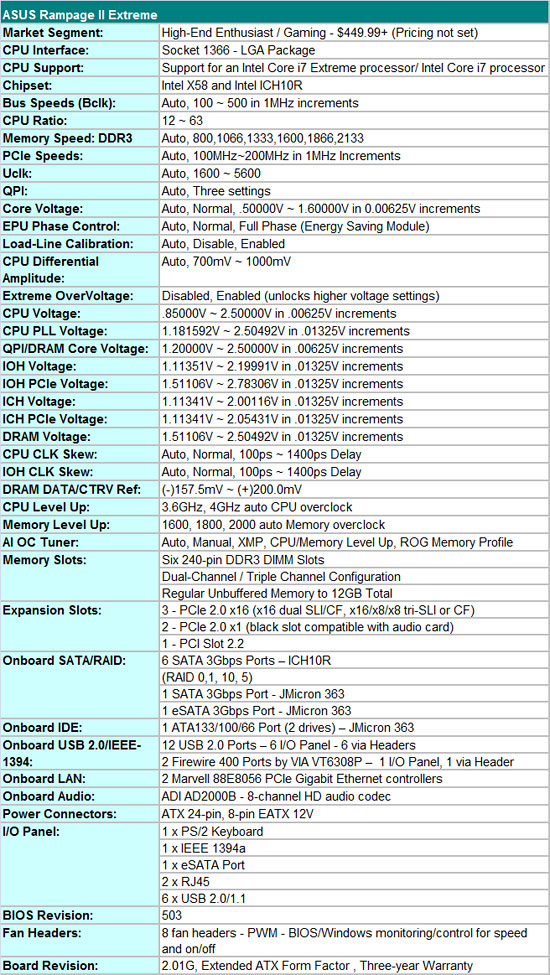
We utilized the ASUS Rampage II Extreme motherboard for our overclocking and memory tests in today’s article. We will take a detailed look at this board and others from MSI, Gigabyte, ASUS again, and Intel in few days. Boards from these particular manufacturers will be available shortly and our review samples now feature retail production kits, not engineering or early production samples.
All of the boards have performed very well so far, but we have been on the BIOS of the day merry-go-round for the last week or so. However, it appears the current BIOS releases are finally to the point of being acceptable for public release, not exactly perfect yet, but a multitude of problems have been addressed over the past few weeks.
That said, this particular board is designed for a very niche market and will see limited production numbers. The mainstream enthusiast board from ASUS will be the P6T Deluxe board, a board that we actually prefer in most cases. This ROG board will be ASUS’s primary weapon in the ultra high-end market against some stiff competition from the Gigabyte EX58 Extreme board. Pricing is not set yet, but we expect it to be around $400. ASUS includes an extensive accessory kit that features their external LCD poster.
As expected with an Republic of Gamers motherboard, the BIOS options are extensive and well laid out. Of note, the QPI/DRAM Core Voltage is not the DRAM voltage setting. We think it should actually be called QPI/IMC or just Uncore voltage. In fact, as we discussed earlier, this voltage setting could potentially be more damaging to the CPU than the 1.65V recommendation on DRAM. Otherwise, the BIOS is straight forward and allows for a myriad of tuning options. We were able to easily get our i7 965 samples up to 4.2GHz on air (not the retail cooler), water, and our CoolIT Systems Freezone Elite. Our i7 920 samples reached about 3.8GHz, although we think there is a possibility for stable 4GHz operation with them.
The Big Picture
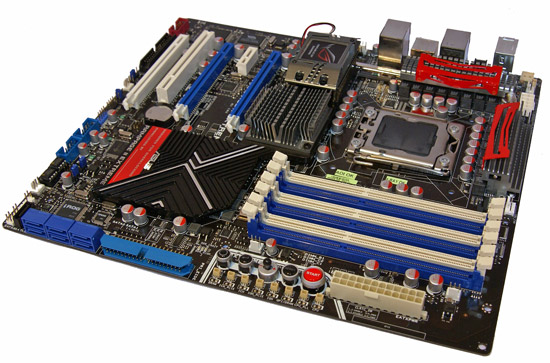
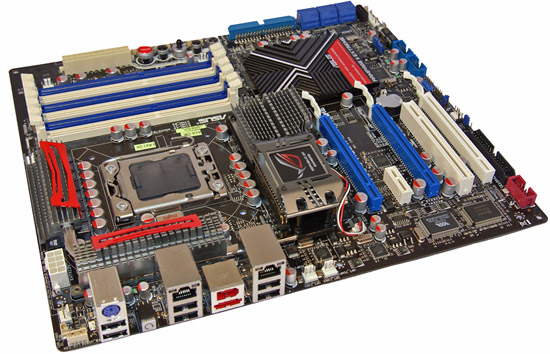
This board compares well to the previous Maximus Formula II and Rampage Extreme boards. We have the return of an eight-layer board dressed out in our favorite black, silver, and Ferrari red primary color scheme. The memory and peripheral slots return in a blue and white motif with the first PCI Express x1 slot that usually houses the SupremeFX X-FI audio card sporting black.
Due to the new LGA 1333 (Socket B1) design that is larger than the current LGA 775 along with six DIMM slots, the area around the CPU is crowded, resulting in a creative layout design that manages to squeeze all the options in a slightly extended ATX format. However, the layout just does not look as clean as previous ROG offerings to us although it is still aesthetically pleasing. ASUS throws in eight fan headers that can be controlled and monitored in the BIOS or via a Windows utility program.
Around the Board
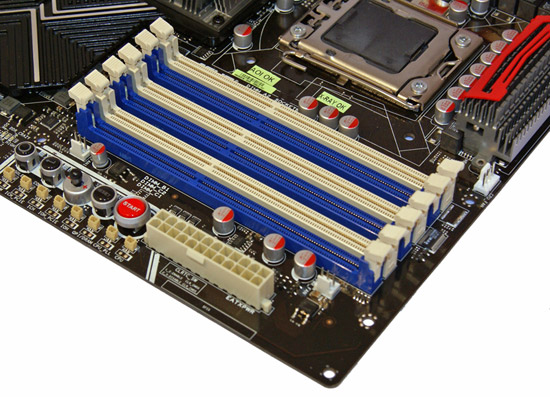
Six DDR3 DIMM slots are included for tri-channel goodness. Performance and compatibility continues to be better when utilizing the blue slots. The memory sub-system receives a three-phase power delivery system.
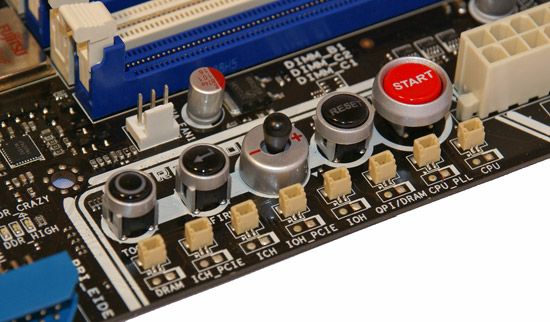
The TweakIT toggle and power/reset switches carry over from the Rampage Extreme board. This system lets you overclock on the fly from within Windows or even during applications when the CPU is loaded. Eight different solder points and pin-outs allow multimeter readings of DIMM, ICH, ICH PCIe, IOH, QPI, CPU PLL, and Core voltages.
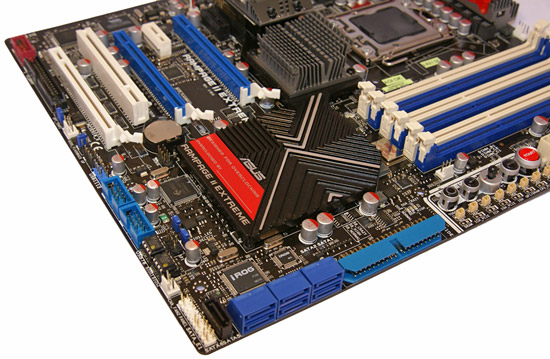
The ICH10R Southbridge is utilized and provides the six SATA ports (dark blue) along with RAID 0,1,5,10. ASUS reverted to the JMicron JMB363 for an extra SATA port (black), an eSATA port on the IO panel and IDE duties. The iROG chipset returns and offers the same features as before, on-board LED control, time keep function, BIOS flashback, additional voltage controls, and a temperature based protection scheme if you enable it.
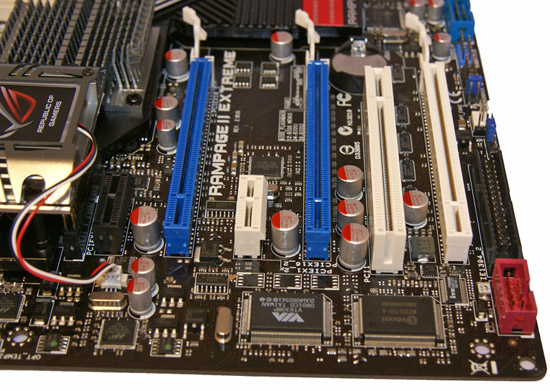
ASUS includes two PCI Express 2.0 x1 slots, three x16 PCIe 2.0 slots (dual x16 or tri x16/x8/x8), and a lonely PCI slot. Tri-Crossfire and SLI support is included, we just need better drivers from AMD/NVIDIA to recognize the graphics potential of this platform. If you utilize double slot GPU cards, the second PCIe x1 slot and the PCI slot will be physically unavailable with a CF or SLI setup.
The black PCIe x1 slot doubles as the HD Audio slot that features the ADI SoundMAX 2000B chipset with support for Creative X-FI 4.0 routines via a software implementation. This is the last hurrah for the ADI chipset as they have exited the on-board audio business but will continue to provide support into the near future.
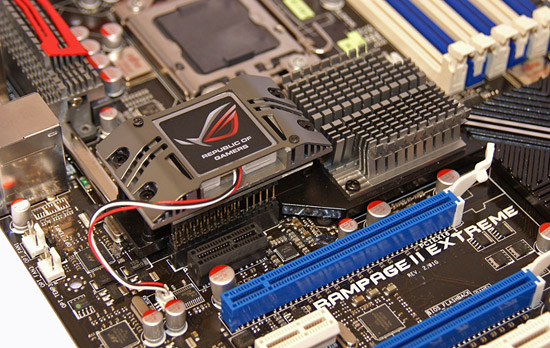
Below the ROG silkscreen is the VTT CPU Power Card. The second heatsink is for the X58 chipset and works quite well in early testing. However, if you are running a CF or SLI setup and need the first PCIe x1 slot for audio or other purposes, you are out of luck as the last set of fins on the heatsink blocks full-length cards. We hope that ASUS will address this before commencing retail production.
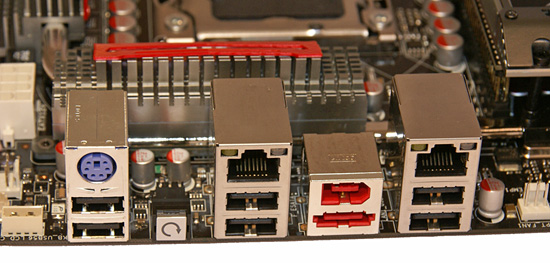
The IO panel is standard and almost legacy free. The PS/2 keyboard port is a nod to the overclocking crowd as is the clear CMOS switch. Six USB 2.0 ports are available along with six more via headers on the motherboard. An IEEE 1394a port courtesy of the fast VIA VT8308P chipset and the eSATA port via a JMicron 363 are included along with dual RJ-45 ports sporting the Marvell 88E8056-NNC1 controller chips that offer teaming capability.
CPU Real Estate
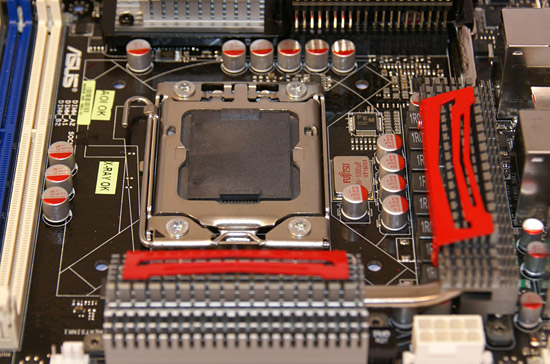
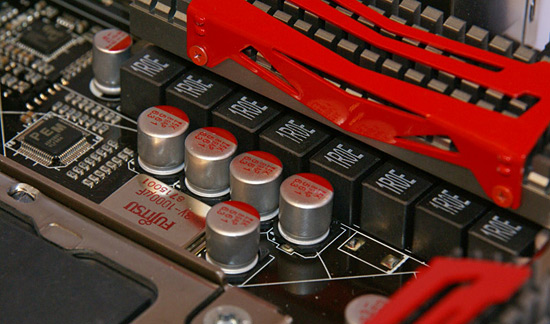
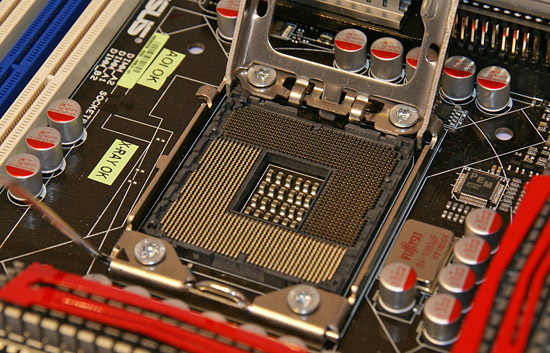
The CPU socket area is crowded but manageable for most cooling setups. ASUS utilizes their “16-phase” power delivery system along with a 3-phase system for the Northbridge. The EPU2 design allows switching between four or sixteen phases to save energy although we think anyone with this board is probably not concerned with it. The board utilizes a combination of Fujitsu ML and Solid Aluminum capacitors.
That concludes our quick overview of the ASUS Rampage II Extreme board. We will be back shortly with full reviews of several X58 boards.










73 Comments
View All Comments
Clauzii - Thursday, November 6, 2008 - link
I still use PS/2. None of the USB keyboards I've borrowed or tried out would work in 'boot'. Also I think a PS/2 keyboard/mouse don't lag so much, maybe because it has it's own non-shared interrupt line.But I can see a problem with PS/2 in the future, with keyboards like the Art Lebedev ones. When that technology gets more pocket friendly I'd gladly like to see upgraded but still dedicated keyboard/mouse connectors.
The0ne - Monday, November 3, 2008 - link
Yes. I have the PS2 keyboard on-hand in case my USB keyboard can't get in :)Strid - Monday, November 3, 2008 - link
Ahh, makes sense. Thanks for clarifying!Genx87 - Monday, November 3, 2008 - link
After living through the hell that were ATI drivers back in 2003-2004 on a 9600 Pro AIW. I didnt learn and I plopped money down on a 4850 and have had terrible driver quality since. More BSOD from the ati driver than I have had in windows in the past 5 years combined from anything. Back to Nvidia for me when I get a chance.That said this review is pretty much what I expected after reading the preview article in August. They are really trying to recapture market in the 4 socket space. A place where AMD has been able to do well. This chip is designed for server work. Ill pick one up after my E8400 runs out of steam.
Griswold - Tuesday, November 4, 2008 - link
You're just not clever enough to setup your system properly. I have two indentical systems sitting here side by side with the only difference being the video card (HD3870 in one and a 8800GT in the other) and the box with the nvidia cards gives me order of magnitude more headaches due to crashing driver. While that also happens on the 3870 machine now and then, its nowehere nearly as often. But the best part: none of the produces a BSOD. That is why I know you're most likely the culprit (the alternative is faulty hardware or a pathetic overclock).Lord 666 - Monday, November 3, 2008 - link
The stock speed of a Q9550 is 2.83ghz, not 2.66qhz.Why the handicap?
Anand Lal Shimpi - Monday, November 3, 2008 - link
My mistake, it was a Q9450 that was used. The Q9550 label was from an earlier version of the spreadsheet that got canned due to time constraints. I wanted a clock-for-clock comparison with the i7-920 which runs at 2.66GHz.Take care,
Anand
faxon - Monday, November 3, 2008 - link
toms hardware published an article detailing that there would be a cap on how high you are allowed to clock your part before it would downclock it back to stock. since this is an integrated par of the core, you can only turn it off/up/down if they unlock it. the limit was supposedly a 130watt thermal dissipation mark. what effect did this have in your tests on overclocking the 920?Gary Key - Monday, November 3, 2008 - link
We have not had any problems clocking our 920 to the 3.6GHz~3.8GHz level with proper cooling. The 920, 940, and 965 will all clock down as core temps increase above the 80C level. We noticed half step decreases above 80C or so and watched our core multipliers throttle down to as low as 5.5 when core temps exceeded 90C and then increase back to normal as temperatures were lowered.This occurred with stock voltages or with the VCore set to 1.5V, it was dependent on thermals, not voltages or clock speeds in our tests. That said, I am still running a battery of tests on the 920 right now, but I have not seen an artificial cap yet. That does not mean it might not exist, just that we have not triggered it yet.
I will try the 920 on the Intel board that Toms used this morning to see if it operates any differently than the ASUS and MSI boards.
Th3Eagle - Monday, November 3, 2008 - link
I wonder how close you came to those temperatures while overclocking these processors.The 920 to 3.6/3.8 is a nice overclock but I wonder what you mean by proper cooling and how close you came to crossing the 80C "boundary"?